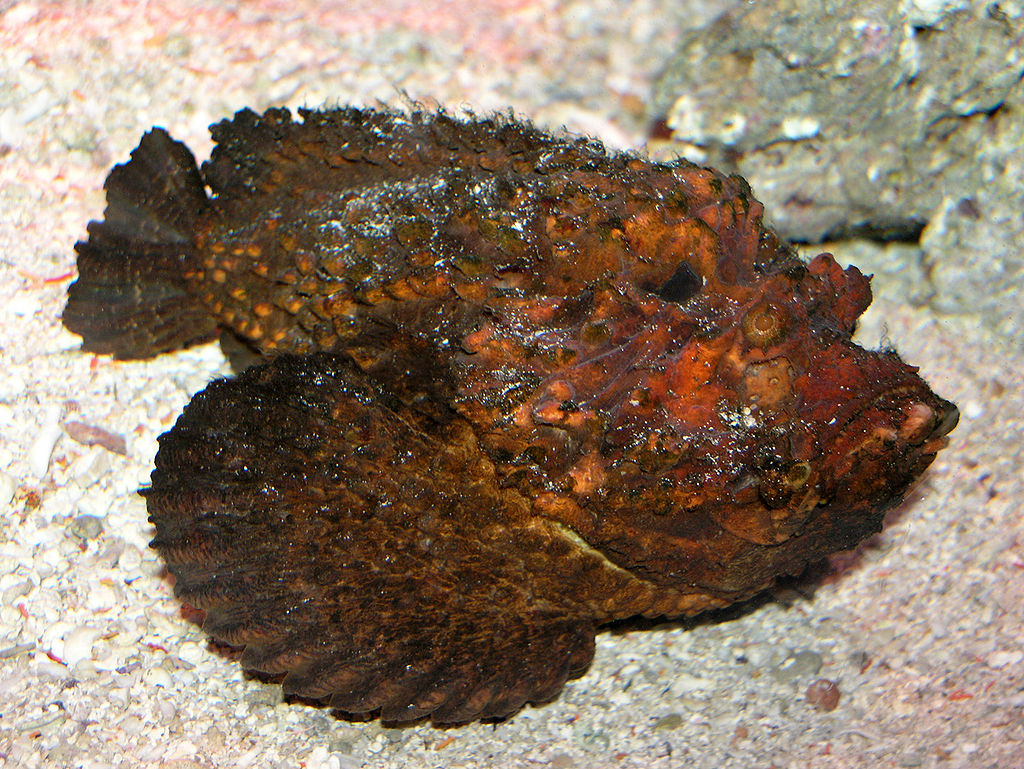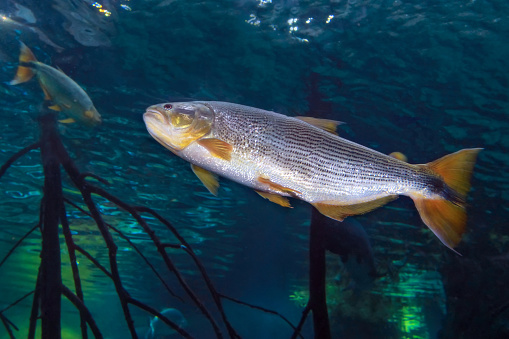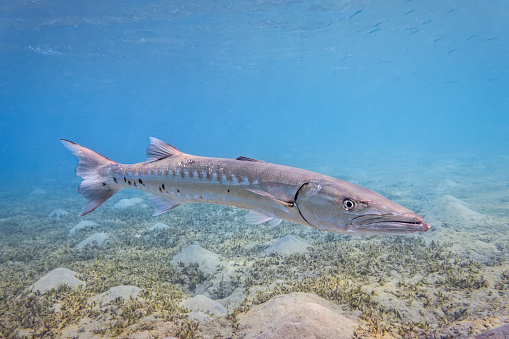Top 12 Most Dangerous Fish in the World 2024 [Must Read]
12 Most Dangerous Fish in the World
There are more than 30,000 different species of fish in the world. The ocean has the smallest to the largest fishes and the most harmless to the deadliest. While killer sharks and whales are dangerous, many others are equally frightening! Some fishes may even look adorable and tiny, but they can still be scary. Let’s find out more about these horrifying creatures!
List of Most Dangerous Fish
1. Stonefish

This fish is considered a terrifying fish. It is also termed as one of the ugliest fish in the world. The scientific name for Stonefish is Synanceia verrucosa. It belongs to the family Synanceiidae. Stonefish live at the bottom of the shallow waters of the tropical Indo-Pacific and the shallow waters of the northern half of Australia. It si also know as most poisonous fish in the world.
The Stonefish usually weighs about 5 pounds. However, it can grow up to a length of 14 to 20 inches. Their body is covered with grey or brown skin with red, yellow, or orange patches. The Stonefish can easily blend into its environment, making it a stealthy fish. They have sharp spikes on their back which helps them to inject venom. Their venom is strong enough to kill an adult human. This is why they’re considered the most venomous fish. So, always be careful about your surroundings when you go swimming!
But, the Stonefish does not use its venom to catch its prey. Instead, Stonefish wait for their prey to come to them and use their strong jaws to capture it, swallowing it whole. Although Stonefish venom is lethal, no human deaths have occurred in recent times due to the development of the anti-venom. However, the anti-venom needs to be applied quickly. Otherwise, the injury may prove fatal.
2. Electric Eel

The extremely dangerous eel is infamous for its enormous amount of body electricity. This fish can attack with about 330 to 650 volts of electricity! The scientific name for the electric eel is Electrophorus electricus. It belongs to the family Gymnotidae.
Electric eels mostly live in freshwater areas. They are commonly found in South America. Electric eel live in the Amazon and Orinoco basins as well. Electric eels can grow up to 6 to 8 feet and weigh around 48 pounds. Electric eel resemble the body of a snake, but their skin is scale-less. The skin is dark gray, while the underside is yellow-orange. The eel’s mouth has several blood vessels, which it also uses as a lung!
Eels release an attack from the electric organs present in their tail, powerful enough to stun a human! The electric eel uses its electric attack to shock its prey. When it senses prey nearby, it discharges two electric jolts, called a doublet. The electric eel swallows the prey with its large mouth, as its teeth are too small to bite it.
Human deaths due to electric eels are extremely rare. However, multiple shocks can lead to severe injury. If someone gets shocked by an eel, they should get out of the water as quickly as possible to prevent drowning.
3. Piranha

It is no surprise that the Piranha fish is included in the list of the topmost deadliest fishes. Even the largest animals consider this small fish as their enemy! The scientific name for Piranhas is Pygocentrus Nattereri, belonging to the family Serrasalminae. Piranhas live in the central and southern water bodies of South America, mainly in tropical rivers and streams. Around 30 fish species of Piranhas live in these rivers and lakes.
Piranhas grow up to 6 to 8 inches and weigh about 3 pounds. The color of their skin varies from silver-orange to black. These fishes are unique due to their teeth structure. They have strong jaws with sharp triangular teeth that help devour a large animal within minutes. Piranhas generally feed on fish, but they can also be found eating insects, birds, or reptiles.
Piranhas move in groups and look for prey. Once a group starts feeding on the prey, other Piranhas rush to the scene and feast on the same. As shocking as it might be to hear, Piranhas have been known to eat humans too! For instance, a six-year-old Brazilian girl was ‘eaten’ by Piranhas in 2015. Hence, it can be clearly seen why the Piranha fish is one of the most dangerous fishes in the world.
4. Tigerfish

The Tigerfish is considered Africa’s deadliest fish. One image of this fish can give you nightmares! The Scientific name for the Tigerfish is Hydrocynus vittatus. It belongs to the family Alestidae.
They are freshwater fish means they live at the bottom of large freshwater rivers and lakes and come close to the surface during the day. The Tigerfish is prominently found in the Congo River Basin and Lake Tanganyika in Africa.
This fish grows up to 3 to 4 feet long and weighs 62 pounds. Fun fact! The largest Tigerfish to ever be caught weighed 155 pounds and was named the “Goliath” Tigerfish! A Tigerfish has silver skin with thin black stripes running across. It also has sharp conical teeth to destroy its prey. The Tigerfish can slice its prey in half with a single bite!
These fishes have been known to attack crocodiles and even birds. When the Tigerfish senses its target, it swims near it and attacks it at a lightning-fast speed. Speed and power are the only two tools a Tigerfish needs to hunt. The Tigerfish is thought to be a man-killer, and several incidents have been reported where these fishes have killed a group of people. Creepy!
5. Needlefish

Needlefish refers to fish belonging to the family Belonidae. Needlefish live in coral reefs, freshwater, open oceans, shallow seas, and coastal waters. They are mainly found near rivers and islands.
They are slender-bodied fishes and can measure anywhere from 2 to 38 inches in length. The Needlefish is also called the Long Tom because of its long body. The fish has an elongated mouth that resembles a needle. Hence, the name!
Due to its thin body, the fish can swim at a speed of 37 miles per hour. Their long narrow beak, which contains multiple sharp teeth, gives them a distinguished identity. The Needlefish feeds on shrimp and small fish like silversides. It follows its prey and jumps at it to catch it sideways in its jaws. The Needlefish is a fast predator. Needlefish have been responsible for occasional deaths and severe injuries in humans. For instance, in 2013, a man in Egypt lost his knee in a needlefish attack. In 2010, a woman in Florida was nearly killed by a needlefish when it penetrated her chest with its long beak! The Needlefish is a fish to beware of!
6. Great Barracuda

The Great Barracuda is one of the fastest fish on this list. The scientific name for the Great Barracuda is Sphyraena barracuda, and it belongs to the family Sphyraenidae. The Great Barracuda commonly lives in coral reefs, mangroves, and seagrasses. They are found in the Atlantic Ocean.
The Great Barracuda is a large fish as it can attain a size of 6 feet, weighing 110 pounds. This elongated fish has brownish or bluish-gray skin. They have powerful jaws with strong and sharp teeth, and the lower jaw protrudes a little more than the upper. These fish depend on their speed of 27 mph to outrun their prey and catch it. They eat larger prey by tearing it into pieces with their sharp teeth.
These fish are called the tiger of the seas due to their large build and ferocity. Attacks on humans by the Great Barracuda are rare. They usually attack if they see a shiny object, mistaking it for their prey. However, they have injured people in boats when they jump out of the water at incredible speeds. A woman was recorded being hit by a barracuda, leading to broken ribs and a punctured lung.
7. Candiru

The Candiru fish is also known as the vampire fish or toothpick fish. The scientific name for Candiru is Vandellia Cirrhosa, and it belongs to the family Trichomycteridae. Their habitat is in the Amazon Basin, particularly in Bolivia, Brazil, Columbia, Ecuador, and Peru.
Candirus are small fish whose standard length is just 7 inches, but some can also grow up to 16 inches. The Candiru has an eel-like appearance and has spines located above the gills. Candirus attach themselves to the gills of larger fish and feed on their blood. Thus they are parasitic.
This fish has also been known for attacking humans unusually. They are believed to be attracted to human urine. When a person urinates in the water, these fishes lodge themselves in the urethra and hold their place with their spines. These fishes may lay eggs in the bladder or eat away the insides, causing severe harm. However, there is limited evidence about this kind of attack.
8. Fugu

A Fugu fish is 25 times more lethal than cyanide! They belong to the family of Tetraodontidae. Fugu inhabits shallow inlet waters and the waters leading to the Pacific Ocean. They generally live in the water bodies of Japan.
There are approximately 40 fish species living in Japan. The fugu fish range in size from 1 inch to almost 2 feet. They are scale-less fish and have spiky skin. They have four teeth that are fused, forming a beak-like structure. The Fugu has the poison tetrodotoxin (TTX) in its skin, liver, ovaries, and intestines. It is the second most poisonous animal / poisonous fish on earth, as its poison can kill an adult human in just a few minutes!
Another defense mechanism of this fish is expansion. They gulp water to swell up like a ball to scare predators away. Due to their slow and clumsy swimming abilities, they use this method, preventing them from outrunning their predators. These abilities of the Fugu make it a strong enemy of the others. The Fugu fish does not attack humans. But more than 100 people die annually because of Fugu poisoning from consuming their meat in sushi!
9. Shark

Sharks are famously known as the most dangerous fish globally, and they are! The scientific name for Sharks is Selachimorpha, and they belong to the family Elasmobranchii. Sharks are widespread worldwide and live in shallow to deep water environments. Some inhabit shallow, coastal regions, whereas others dwell on the ocean floor.
Sharks come in all sizes. The largest Shark is the Great White Shark, with 23 feet weighing 5,000 pounds! Their skin is dull gray and has toothlike scales. Sharks have an upturned tail which is extremely powerful. They also have sharp triangular sharp teeth to chomp down their prey. An interesting fact about sharks is that they do not have a swim bladder. So, they have to swim constantly to prevent sinking.
Sharks have an acute sense of smell that enables them to smell blood from miles away! Sharks have ‘lateral lines’ that run across their body that help them sense their prey. Before attacking its prey, a shark circles it from far away to not alarm it. All sharks have detachable jaws to thrust them forward and catch their prey. Sharks are responsible for an average of ten human deaths per year worldwide. There were 57 provoked bites on humans confirmed in 2020 alone!
Also Read: Tiger shark facts
10. Puffer

Pufferfish refers to fish belonging to the family Tetraodontidae. The Tetraodontidae contain 193 species of puffers in 28 genera. They have unique features which vividly distinguish them from other fish. They can inflate themselves at any time simply by gulping down mouthfuls of water, hence the name!
The body of the Puffer is covered with venomous spikes. These spikes help the fish scare off predators and capture their prey. The Puffer can be held in captivity in aquariums as these fishes are visually attractive when they bloat. They are also eaten as delicacies in many areas. It is an amusing image to look at when these fishes inflate!
11. Red Lionfish

The Red Lionfish are beautiful to look at and one of the most dangerous fish in the world. The scientific name for Red Lionfish is Pterois volitans, and it belongs to the family Scorpaenidae. They primarily live in coral reefs in the tropical waters of the South Pacific and Indian Oceans. However, they are spread across the world.
The largest lionfish can grow up to 15 inches! These fishes have distinctive brown or maroon skin with white stripes covering the head and the body. They have 13 dorsal spines through which they deliver their venom. However, they do not use their venomous spines to catch their prey. Instead, they use their large pectoral fins to strike their prey and swallow it in a single bite.
Fortunately, their stings do not cause fatal injuries to humans. But they can still cause nausea, fever, breathlessness, and even cardiac arrest. Furthermore, we see that these fishes have an aggressive attitude towards divers and fishermen. Hence, the Red Lionfish perfectly applies to the saying, ‘do not judge a book by its cover!’
12. Yellow Boxfish

The scientific name for the Yellow Boxfish is Ostracion cubicus, and it belongs to the family Ostraciidae. They are also called cube trunkfish or polka-dot boxfish. It inhabits the reefs of the Pacific, Indian and southeastern Atlantic Oceans.
They dwell at depths of up to 40 meters. These fishes grow up to 17 inches and usually weigh just 2 pounds. These fishes have box-shaped bodies with bright yellow skin and black spots, covering the entire body. Their tail fin is an important feature that keeps them afloat. It feeds on a range of tiny organisms, including mollusks, worms, and algae. Yellow Boxfish is also known as poisonous fish. The Yellow Boxfish can release a poisonous substance, called ostracitoxin, that can kill other fishes in its surroundings. The Yellow Boxfish does not attack humans as it is not an aggressive fish. However, it is best to avoid them.
Also Read: Hammerhead shark
FAQs
What is the most dangerous fish to eat?
The Japanese delicacy fugu, or blowfish, is the most dangerous fish to eat as it can cause severe poisoning if not prepared correctly. Therefore, special training is provided to chefs to teach them how to make fugu dishes.
What kind of dangerous fish can attack sailboats?
Sharks are one of the most dangerous fishes that can attack sailboats. They use their fins to hit the boats underwater and can even topple the sailboat completely, throwing the people into the water.
What is the biggest shark?
The biggest shark is the Whale Shark which grows up to 60 feet and weighs about 21 tons! Imagine the amount of destruction it can do.
What fish can swallow a human whole?
Sharks can swallow a human whole. The Great White Shark can eat a full human with powerful jaws and more than 300 teeth!
Can piranhas eat a human being alive?
Yes, piranhas can eat a human being alive. However, it rarely happens. There are only a few cases reported about the same.
Fish are generally not aggressive creatures, but they attack humans when provoked. Hence, it is best to keep away from these 12 deadliest fishes!
